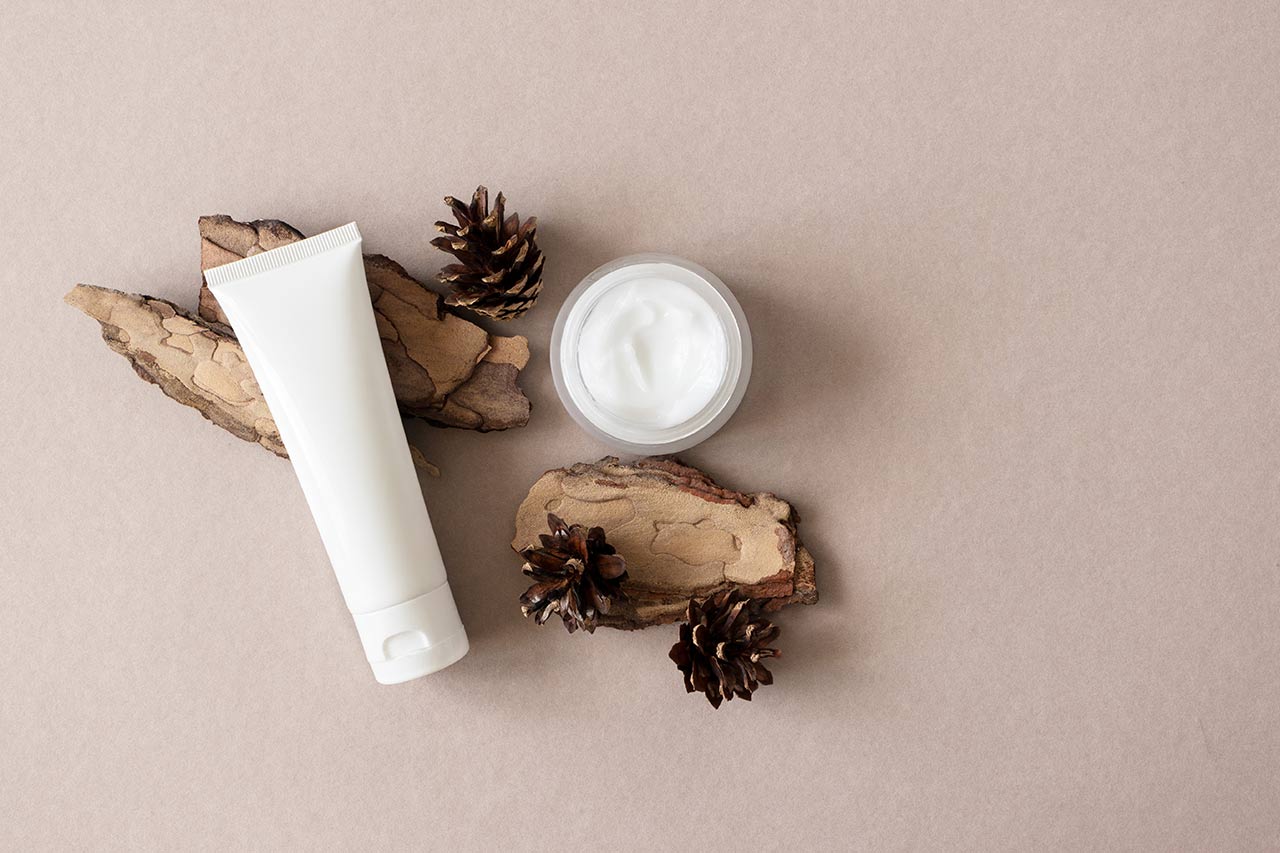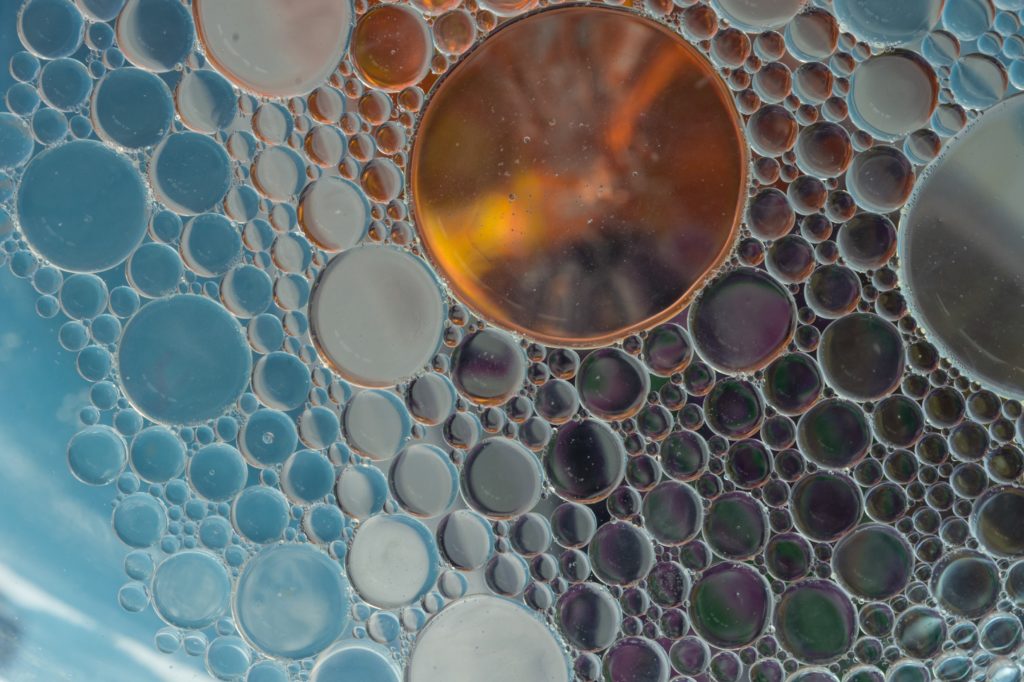What is hyaluronic acid and how is it used in aesthetic procedures?
Hyaluronic acid is a polysaccharide molecule and one of the main components of connective tissue, forming a gelatinous matrix that surrounds cells. Its water-binding and water-attracting (hygroscopic) properties fill the gaps between collagen and elastin connective fibers in the dermis. Hyaluronic acid is synthesized by fibroblasts in the dermis and degraded in just a few hours. Degraded hyaluronic acid fragments will in turn stimulate fibroblasts to produce hyaluronic acid and collagen. However, this balance, known as “homeostasis”, is altered over time, and the natural capital of hyaluronic acid gradually diminishes, partly explaining skin ageing. To counter this, a wide range of hyaluronic acid-based products are available. Within this varied range, there are two main types of hyaluronic acid:
Cross-linked hyaluronic acid
Cross-linking is a chemical process using a complexing agent to bind linear hyaluronic acid molecules together, resulting in new structures composed of several hyaluronic acid filaments of higher molecular weight. The higher the degree of cross-linking, the more compact the product and the greater its resistance to natural degradation. Cross-linked hyaluronic acid is therefore a synthetic product.
Cross-linked hyaluronic acid is used in injections of “classic” hyaluronic acid-based dermal fillers. Its main applications are to fill deep wrinkles and restore volume, and its duration of action ranges from 6 to 12 months or more, depending on the patient and the products used.
Non-cross-linked hyaluronic acid
Non-cross-linked hyaluronic acid is the closest to the hyaluronic acid naturally present in our skin. It is used in mesotherapy micro-injections and topical moisturizing creams, to give skin radiance by plumping and hydrating it. It is often combined with vitamin complexes. It has an immediate effect, within 24-48 hours, and also a progressive, longer-term effect, over the course of several sessions, thanks to its action in stimulating fibroblasts (dermal cells).
The worldwide boom in hyaluronic acid injections
Hyaluronic acid injections are extremely popular. They were second only to botulinum toxin in the top 5 non-surgical procedures worldwide, and will account for 30% of all non-surgical procedures by 2021.
Hyaluronic acid is therefore widely used, and sometimes highly democratized, leading to certain abuses such as risk minimization, lack of formula transparency, and procedures carried out by unauthorized personnel.
Issues and concerns related to the use of hyaluronic acid
Issue n°1: Informing patients about the potential risks of cross-linked hyaluronic acid fillers
Among non-surgical aesthetic procedures, hyaluronic acid-based cross-linked fillers can induce complications ranging from mild side effects (redness, bruising, etc.) to rare but very serious consequences (infections, necrosis, permanent asymmetry, vascular occlusion, stroke, blindness, and even death).
In addition to being a risky procedure due to the injection itself, the fate and degradation of cross-linked hyaluronic acid considered as foreign bodies remains uncertain today. Years after injection, side effects such as swelling can occur, and residues of cross-linked hyaluronic acid can still be detected in the skin.
It seems essential that manufacturers clarify the nature of hyaluronic acid, its function and fate, at the very least on the packaging and leaflets of marketed products, to raise general awareness of the risks involved, among practitioners and patients alike.
Find out more about our experience in the cosmetics industry >
Issue n°2: Communicate more effectively on hyaluronic acid’s action and ensure rigorous traceability of injectable products
Injectable product manufacturers and distributors are “unclear” about the exact nature of their hyaluronic acid on packaging and leaflets. Slightly cross-linked and non-cross-linked hyaluronic acid are sometimes confused.
For example, there may be a difference between the general message from distributors that hyaluronic acid used in mesotherapy is non-cross-linked, whereas formulators/practitioners speak of slightly cross-linked, stabilized or reinforced hyaluronic acid.
There is also confusion between hyaluronic acid in topical formulations and hyaluronic acid in injected fillers. Some topical hyaluronic acid products are misleadingly marketed as topical “fillers”. Topical hyaluronic acid only hydrates the surface, due to the size of the molecules, and does not act as a filler.
Clear communication from formulators on the role and action of hyaluronic acid in different injection products or topical applications is therefore essential.
What’s more, cosmetic injectables are readily available for purchase by the general public from retail giants and online marketplaces, without the need for information demonstrating medical licensure.
Strict regulations governing the distribution of injectable products, with real product traceability, therefore seem necessary.
Issue n°3: Clarifying the medical status of hyaluronic acid injection procedures
The United States and Brazil are the two leading countries in terms of the number of hyaluronic acid injections performed each year (respectively 30% and 7% of hyaluronic acid injections performed by plastic surgeons worldwide). A very wide range of medical and non-medical practitioners, some of them unqualified, work in very different environments.
In the USA and Brazil, only doctors and dentists can perform injections, and only under supervision for paramedics and nurses, depending on country and state regulations. However, there is legal uncertainty as to the exact definition of physician supervision and the delegation of a medical representative to an assistant or nurse.
On the other hand, in these countries and throughout the rest of the world, aesthetic professionals without medical qualifications are not allowed to perform injections. These professionals work in medical spas or beauty clinics, which account for 50% of the aesthetics market in the USA and Brazil. However, there are more side effects and complications associated with hyaluronic acid injections in these centers than with medical professionals, proving that injections are carried out there illegally and less safely.
Indeed, these centers offer less costly procedures that give patients more options, due to the absence of standardized care protocols. As a result, patients more frequently suffer complications due to the lack of education, training, and experience of these practitioners.
The line between medical and aesthetic procedures has become increasingly blurred, to the detriment of consumers.
Injection should not be seen as a simple, trivial act, and the medical status of injection procedures should be reconsidered. For example, the American Med Spa Association recommends that regardless of whether a state has designated a treatment as “non-medical”, if it meets the definition of a medical procedure – i.e. it impacts or affects living tissue – then the treatment in question should be considered a medical treatment.
In terms of consumer safety, the democratized use of hyaluronic acid-based products must now be readjusted with the adoption of a clear and precise discourse on the nature and uses of this molecule, in order to raise awareness throughout the value chain, from manufacturer to consumer. Alcimed is at your side to support you in your projects relating to the cosmetics of tomorrow. Don’t hesitate to contact our team!
About the author,
Ella, Consultant in Alcimed’s Cosmetics & Luxury team in France



